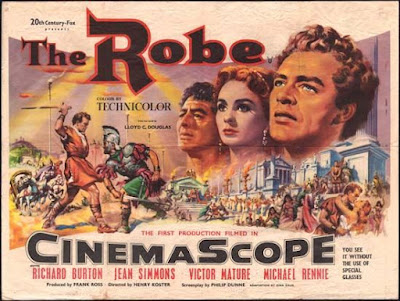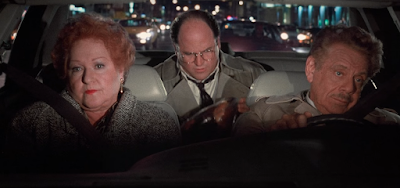The modern thriller classic “Michael Clayton” (2007) is currently streaming on Netflix and so perhaps that’s why just recently I saw someone on Elon Musk’s Latest Attention-Grabbing Venture to Eventually Abandon (i.e. Twitter) lauding the MCU – Michael Clayton Universe, that is, as opposed to more fashionable Marvel Cinematic Universe. I can’t source the Tweet now, though in trying to I found a few other people who have, in the last few years, made a variation of this same joke. So, it’s nice to know that there are other “Michael Clayton” fans and, more crucially, Thriller-heads out there too. Now, Cinema Romantico is generally against such cinematic universes. This blog believes it stifles creativity rather than encouraging it and has gone a long, long way into turning Movies, glorious Movies, into TV. But we also not-seriously demand equal CU time. As we have argued before, if you get your MCU, why can’t we have our NKCU (Nicole Kidman Cinematic Universe)? That’s only fair. And that brings me to the Michael Clayton Universe – namely, what films could we create for it? This post is incredibly niche, I know. but then, Marty Bach (Sydney Pollack) compliments Michael Clayton on having a “niche,” so maybe that’s appropriate.
Possible Movies of the MCU (Michael Clayton Universe)
1.) Let’s get the ball rolling with an easy one, the obvious one – Mr. Verne (Robert Prescott) and Mr. Iker (Terry Serpico), the rival fixers cum assassins. We wouldn’t see what they were up to after their botched hit of Michael goes wrong but see what they were up to before, a Mr. Verne and Mr. Iker prequel of sorts, beginning with them being called away from another round of golf to attend to another dastardly job, probably involving a sweaty charlatan played by Sam Rockwell with a greasy moustache, a frantic Winona Ryder, and Keith David as a detective who is too old for this shit.
2.) Clearly a whole movie is waiting to get out of the poker game in the basement of the Chinese restaurant.
3.) Mr. (Denis O’Hare) and Mrs. (Julie White) Greer could effect a whole riff on “Who’s Afraid of Virginia Woolf?” during the former’s hit and run trial.
4.) “He’s an asshole,” Marty Bach says of Barry Grissom (Michael O’Keefe), one of his firm’s attorneys, “but he knows it.” And doesn’t that, the self-aware asshole, sound just like a burgeoning protagonist of a John Grisham Movie in the Michael Clayton Universe? I mean, merging the JGU with the MCU unlocks all sorts of golden doors. Suddenly you’re looking at the potential for George Clooney & Sandra Bullock or Tilda Swinton & Mickey Rourke as co-headliners. The sky’s the limit.
5.) But then, part of what makes “Michael Clayton” so great is that eschews romanticizing The Law a la Grisham. So. What if we make an entire movie of Arthur Edens (Tom Wilkinson) “grind(ing) away on this case for six years without a break”? Like Irv Blitzer in “Cool Runnings” showing the prospective Jamaican Bobsled team footage of bobsled crashes to let them know what they’re getting themselves into, we will show this MCU movie to prospective law school students. Maybe this how we can begin infusing the world with more English majors.
5.) But then, part of what makes “Michael Clayton” so great is that eschews romanticizing The Law a la Grisham. So. What if we make an entire movie of Arthur Edens (Tom Wilkinson) “grind(ing) away on this case for six years without a break”? Like Irv Blitzer in “Cool Runnings” showing the prospective Jamaican Bobsled team footage of bobsled crashes to let them know what they’re getting themselves into, we will show this MCU movie to prospective law school students. Maybe this how we can begin infusing the world with more English majors.
6.) Speaking of which…remember all those apple-faced law firm newbies who look scared witless in the hotel room after Arthur goes off the deep end during the deposition (including a pre-fame Katherine Waterston)? Let’s follow them as they quit their jobs to follow The Grateful Dead. Roll up those billable hours and smoke ’em.
7.) Michael flaming out at trying to get into the restaurant business with the mob would make for a killer MCU movie. We’ll convince Marisa Tomei to ditch the MCU for the MCU to play a New York State Liquor Authority commissioner.
8.) When Karen Crowder (Swinton) is going through Michael’s credentials it’s noted that in 1986 he worked with the Joint Manhattan-Queens Organized Crime Task Force. A 1980s crime thriller in the MCU?! “Jonathan, bring me my green light!”
9.) Remember the part where Michael is on the phone in his office, kind of going through the motions in doing his job, talking to who-knows-who about some 22-year old charged with reckless endangerment in Key Biscayne? I’m seeing “Michael Clayton...Goes to South Florida” with Clooney looking miserable, just absolutely miserable, in a floral print shirt and Andy Garcia as some corrupt local politician conducting his business outside a walk-up coffee window.
10.) A Blank Check Movie in which we give Merritt Wever a blank check to just take her character wherever she wants.
11.) Karen Crowder’s Law School Adventures, in which we discover young Karen Crowder (still played by Swinton somehow) is both hyper-ambitious and problematically conceited, forced to enlist the law school version of Mr. Verne and Mr. Iker (Abbi Jacobson, Awkwafina) to help her graduate at the top of her class.
12.) A wacky body switch comedy in which Michael Clayton the fixer magically changes places with Michael Clayton the football player!
12.) A wacky body switch comedy in which Michael Clayton the fixer magically changes places with Michael Clayton the football player!



































